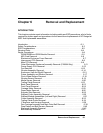
5-5Functional Overview
PRINTED CIRCUIT ASSEMBLY (PCA) OVERVIEW
MAIN PCA
There are two clocks on the main PCA. The main clock provides a 31.85 MHz signal directly
to the main processor. The 31.85 MHz is divided by the main processor, and the resulting
signal is provided to the processor support ASIC. A separate clock provides a 12 MHz signal
to the servo processor.
In order to perform its functions, the main processor must have access to its memories (ROM
and DRAM). To create plots at the direction of an external controller, it must be able to com-
municate with the controller by way of its interfaces (MIO, Centronics, and RS-232-C). To
address the ROM or DRAM interface, the main processor places the appropriate address on
the address bus and reads or writes the data directly. Data is passed to the main processor by a
transceiver in the case of ROM or DRAM SIMM data. MIO or Centronics input and output
data pass through another transceiver on its way to the main processor.
The main PCA ROM contains the following types of information:
Programs
Program constants
Character sets
Demonstration plot
The main PCA DRAM is used to store the following types of information:
Variables
Temporary constants
Plots
As a plot is received from an external controller by way of one of the plotter interfaces, it is
stored in DRAM. When the complete plot is in DRAM, the main processor converts it, one
swath at a time, to a format suitable for storage and sends it to swath RAM by way of the
processor support ASIC. A swath is 96 dots high and extends from border to border across the
width of the plot. The processor support ASIC extracts the plot data from the swath RAM,
converts it to pixels, and sends the pixels serially by way of the trailing cable to the carriage
ASIC on the carriage PCA.


















